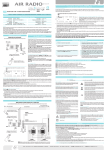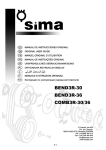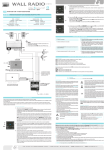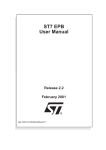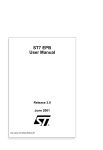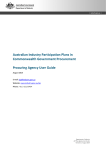Download Implementation Report User Guide
Transcript
Australian Industry Participation Plans User Guide for developing an Implementation Report August 2014 E-mail: [email protected] Website: www.industry.gov.au/aip Phone: +61 2 6213 6404 Department of Industry Implementation Report User Guide Version 2.1 August 2014 Contents Australian Industry Participation Plans User Guide for developing an Implementation Report ............................................................................................................................................. 1 1. Introduction .................................................................................................................. 3 2. About this User Guide .................................................................................................... 4 3. What is an Implementation Report? .............................................................................. 5 4. 5. 3.1 How to prepare an Implementation Report ............................................................ 5 3.2 Submitting an Implementation Report.................................................................... 7 3.3 Evaluation of Implementation Reports ................................................................... 7 3.4 Publishing Implementation Report outcomes ......................................................... 7 3.5 Reviewing Implementation Report outcomes ......................................................... 7 3.6 AIP Plan Annual Report........................................................................................... 7 Detailed Implementation Report Outcomes ................................................................... 8 4.1 Outcome 1: Actual outcomes for Australian industry involvement.......................... 8 4.2 Outcome 2: Communication strategy ................................................................... 13 4.3 Outcome 3: Opportunities through all tiers of supply and in all stages of the project 15 4.4 Outcome 4: Opportunities for longer-term participation ...................................... 18 4.5 Outcome 5: Procedures and resources ................................................................. 21 Related Programmes ................................................................................................... 23 5.1 Enhanced Project By-law Scheme ......................................................................... 23 5.2 Entrepreneurs’ Infrastructure Programme............................................................ 23 5.3 Industry Capability Network ................................................................................. 23 5.4 Export Finance and Insurance Corporation (Efic)................................................... 23 Attachment A ...................................................................................................................... 25 Abbreviations and acronyms .......................................................................................... 25 Key Concepts and Definitions ......................................................................................... 25 Department of Industry Implementation Report User Guide Version 2.1 August 2014 2 1. Introduction The Australian Industry Participation (AIP) Plan has been developed in accordance with the principles and strategic approaches of the AIP National Framework (the AIP National Framework). The AIP National Framework provides a nationally consistent approach to maximising Australian industry participation in investment projects and significant public and private sector activity. The AIP National Framework was agreed between Commonwealth, state and territory governments in 2001 to promote, develop and maintain a sustainable Australian industry capability by encouraging competitive Australian industry participation in investment projects. The key principle of the AIP National Framework is to provide Australian industry, especially small and medium sized enterprises (SMEs), with full, fair and reasonable opportunity to participate in major investment projects, in Australia and overseas. The AIP National Framework does not mandate the use of Australian industry. It is about providing opportunity for capable and competitive Australian industry to participate in major projects. The AIP National Framework supports AIP programmes and initiatives that aim to encourage industry to meet world’s best practice through capability building; identifying early stage opportunities for industry participation both domestically and overseas; promoting Australian capability and integration of industry into global supply chains; and enhancing project facilitation and participation. The AIP National Framework is available at www.industry.gov.au/aip. Department of Industry Implementation Report User Guide Version 2.1 August 2014 3 2. About this User Guide The Australian Industry Participation Plans: User Guide for developing an Implementation Report (Implementation Report User Guide) outlines the steps required to be taken by an organisation, including SMEs, if they are required to develop an Implementation Report. It includes detailed descriptions of how to prepare an Implementation Report and how to report on the outcomes achieved. Implementation Reports may be required from organisations that have developed an AIP Plan for the Australian Government initiatives outlined in Section 3 of the Australian Industry Participation Plans: User Guide for developing an AIP Plan (AIP Plans: User Guide). Organisations are encouraged to contact the Department of Industry early in the process and use the template available at www.industry.gov.au/aip when preparing their Implementation Report; however organisations are free to develop their own document. The Implementation Report User Guide should be read in conjunction with the relevant AIP Plan Guide for Procuring Agencies or Granting Agencies and the AIP Plans: User Guide. These User Guides, and associated documents, are available at www.industry.gov.au/aip. This User Guide may be updated from time to time. To ensure you are using the most up to date version you should visit the Australian Industry Participation website at www.industry.gov.au/aip. Department of Industry Implementation Report User Guide Version 2.1 August 2014 4 3. What is an Implementation Report? If an organisation is successful, it will be contractually required to implement its Approved AIP Plan and report on its implementation through an Implementation Report. An Implementation Report documents the actions and activities that have been undertaken to implement the AIP Plan. The Implementation Report should detail how full, fair and reasonable opportunity was provided to include capable Australian industry in the project. The outcomes that were achieved as a result of these actions should be documented in the Implementation Report. Evidence of these actions and outcomes should be provided as an attachment. To assist organisations to prepare an Implementation Report, a template for developing an AIP Plan and Implementation Report is available at www.industry.gov.au/aip or organisations can develop a similar document. The concept of providing full, fair and reasonable opportunity to Australian industry is the core principle of the AIP National Framework. The definitions are as follows: Full – Australian industry has the same opportunity afforded to other global supply chain partners to participate in all aspects of a project (e.g. design, engineering, project management, professional services and IT architecture). Fair – Australian industry is provided the same opportunity as global suppliers to compete on projects on an equal and transparent basis, including given reasonable time in which to tender. Reasonable – tenders are free from non-market burdens that might rule out Australian industry and are structured in such a way as to provide Australian industries the opportunity to participate in projects. The contracting agency will be responsible for ensuring the receipt of an adequate Implementation Report and will share information with and consult with the Department of Industry. On request, the Department of Industry will provide advice to organisations preparing Implementation Reports. It is recommended that organisations contact the Department of Industry early after the award of a contract or grant. The Department of Industry can provide assistance and advice to assist in implementing and reporting on the AIP Plan. If you require guidance on Implementation Reports, please contact the Department of Industry by: Email: [email protected] Phone: +61 2 6213 6404 3.1 How to prepare an Implementation Report The outcome of each action/strategy in the AIP Plan should be reported on in the Implementation Report. Each outcome should contain the following key components: • What evidence is provided to demonstrate that the action/strategy was implemented • What outcome was achieved through the action/strategy implementation Department of Industry Implementation Report User Guide Version 2.1 August 2014 5 More detailed guidance on how to report on the implementation of AIP Plan actions/strategies is provided in Section 4: Detailed Implementation Report Outcomes. An example of how to write up an Implementation Report statement of outcomes is outlined in Table 1. Table 1 An example Implementation Report that includes Action, Evidence and Outcome Stage How to write the Implementation Report outcome AIP Plan Action 1 Engagement with the Industry Capability Network (ICN): [Organisation] will engage with the Industry Capability Network (ICN) to nominate potential suppliers of goods and services relevant to the contract. [Organisation] will provide the ICN with a list of goods and services which will be required to complete the contract. These will be listed on the ICN Gateway website. [Organisation] will use ICN’s nominated suppliers to supplement our existing supplier database and these will be invited to respond for the provision of goods and services required to undertake the contract. Implementation Report Evidence Implementation Report Outcome Attached are the following documents: • Letter confirming engagement with the ICN. • List of goods and services provided to the ICN which were required to undertake the project. • Screenshot from ICN Gateway website showing the list of goods and services required for the project. • List of potential Australian suppliers provided by ICN. • Copy of a request for a quote sent to one of the new Australian suppliers. • List of successful new Australian suppliers of goods and services and value of contracts. • 12 companies were provided by the ICN of which nine new Australian companies were added to our supplier database as three were already included. • 25 relevant companies from our supplier database (depending on good or service required) were approached and invited to provide a quotation including all identified by the ICN. • 10 current suppliers were awarded contracts valued at $15 million. • Five new companies awarded contracts valued at $2 million (see attachments). Department of Industry Implementation Report User Guide Version 2.1 August 2014 6 3.2 Submitting an Implementation Report The submission date for Implementation Reports will vary for each major Commonwealth project contract incorporating an AIP Plan. The submission date of each successful organisation’s Implementation Report will be specified in the contract between the agency and organisation. The Implementation Report is provided to the contracting agency which will provide a copy of the Final Implementation Report to the Department of Industry. 3.3 Evaluation of Implementation Reports Implementation Reports will be contractually required to be provided to the contracting agency by the successful organisation. An Implementation Report will only be acceptable if evidence is provided that the AIP Plan has been implemented as agreed and all essential elements of the Implementation Report are provided. Where an Implementation Report is incomplete or does not provide sufficient evidence that the AIP Plan has been implemented as agreed, advice will be provided to the organisation of any additional information required. This information should be provided within the specified timeframe of the request being sent by the contracting agency. If the additional information is not received within the specified timeframe, the Implementation Report will be deemed non-compliant. 3.4 Publishing Implementation Report outcomes The Department of Industry will publically report the estimated total percentage of Australian industry value added as part of the Implementation Report outcomes i.e. the 61 per cent figure from the example included in Section 4.1.2 below. This figure will be published in the Executive Summary of the organisation’s AIP Plan which can be found at www.industry.gov.au/aip. This figure will be published once the Implementation Report has been approved by the contracting agency. The contracting agency will be responsible for providing the Department of Industry with a copy of the acceptable Implementation Report to allow for the Australian industry value to be published for each organisation/project. 3.5 Reviewing Implementation Report outcomes In conjunction with the contracting agency, the Department of Industry may follow up on the implementation of selected AIP Plans in order to monitor the effectiveness of these AIP Plans in providing benefits to the organisation and suppliers of goods and services to the organisation. The Department of Industry will select major Commonwealth projects each year for these reviews. 3.6 AIP Plan Annual Report The Australian Government will prepare an Annual Report on AIP Plans and outcomes. Information provided to the Department of Industry through AIP Plans and Implementation Reports will be incorporated into this Annual Report. Department of Industry Implementation Report User Guide Version 2.1 August 2014 7 4. Detailed Implementation Report Outcomes Please Note: Information provided in Section 1 Organisation and project details of the AIP Plan does not need to be updated at Implementation Report stage. 4.1 Outcome 1: Actual outcomes for Australian industry involvement This outcome reports on the opportunities and Australian industry value added achieved by the project. This includes contracts awarded to Australian industry to supply goods and services purchased by the organisation in undertaking the project. In addition, the following estimates of Australian and New Zealand industry value added should be provided: • Australian industry value added in purchased goods and services at the time the Implementation Report is submitted; • Estimated Australian industry value added through the construction phase of the project; and • Estimated Australian industry value added over the operation phase of the project. 4.1.1 Australian industry value added in purchased key goods and services Australian industry value added in purchased key goods or services is defined as: the supply price of the key good or service less the amount spent on imported inputs to that good or service. The value of imported goods and services includes all components, embedded software and design, manufacturing, assembly and supply services used for, or in the supply of, those products or services. This can be calculated by: From the estimated purchase value of the key good or service, subtract the estimated value of the imported inputs to that key good or service. When calculating estimated Australian industry value added in purchased goods and services, applicants should take into consideration where the process of transformation takes place or the service is delivered from, not simply the geographical location of the supplier. For example, a contract may be provided to an Australian organisation that then purchases the good from overseas. The overseas component should be included as an imported good in the calculation of Australian industry value added. Tables 2 to 4 below provide examples of how Australian industry value added in key goods and services can be calculated. Department of Industry Implementation Report User Guide Version 2.1 August 2014 8 Table 2 Example of calculating Australian engineering services industry value added Actual Australian engineering services contracts Value Per cent $900 000 100% Actual imported inputs less $0 0% Actual Australian engineering services industryvalue added equals $900 000 100% Value Per cent $3 000 000 100% Table 3 Example of calculating Australian IT industry value added Actual cost of IT hardware Actual imported components less $2 100 000 70% Actual Australian industry-value added equals $900 000 30% Table 4 Example of calculating Australian electrical and computer services industry value added Actual cost of electrical and computer cabling Value Per cent $250 000 100% Actual imported goods less $150 000 60% Actual Australian industry-value added equals $100 000 40% Table 5 provides an example of how the table would be completed in the Implementation Report. The table should reflect the key goods and services identified in the organisation’s AIP Plan plus any additional key goods and services purchased that were not previously identified in the AIP Plan. Department of Industry Implementation Report User Guide Version 2.1 August 2014 9 Table 5 Example of actual opportunities for industry participation Actual opportunities for Australian industry Actual Australian industry value added (as % value of total contract value) Procurement of Design services 100% Procurement of Construction services 92% Procurement of Engineering services 100% Procurement of Information Technology – Hardware 30% Procurement of Information Technology – Software 25% Procurement of Transport services 100% Procurement of Electrical and computer cabling 40% Organisation costs 80% 4.1.2 Estimated total Australian industry value added in purchased goods and services Please note: Organisations should provide their best estimate at the time the Implementation Report is submitted. Estimated total Australian industry value added in purchased goods and services is defined as: the estimated value of purchased goods and services less the estimated amount to be spent on imported goods and services. The latter includes all components, embedded software and design, manufacturing, assembly and supply services used for, or in the supply of, those products or services. This can be calculated by: From the estimated total purchase value of goods and services for the project, subtract the estimated total imported goods and services. When calculating estimated total Australian industry value added in purchased goods and services, applicants should take into consideration where the process of transformation takes place or the service is delivered from, not simply the geographical location of the supplier. For example, a contract may be provided to an Australian organisation which then purchases the good from overseas. The overseas component should be included as an imported good in the calculation of Australian industry value added. Table 6 below provides an example of how to calculate total Australian industry value added in key goods and services. Department of Industry Implementation Report User Guide Version 2.1 August 2014 10 Table 6 Example of calculating estimated total Australian industry value added in purchased goods and services Purchased goods and services Estimated Value Per cent $40 million 100% Imported goods and services less $15.5 million 39% Total Australian industry-value added in purchased goods and services equals $24.5 million 61% Table 7 provides an example of how the table would be completed in the Implementation Report. The table should reflect the estimated percentage of Australian industry value added in purchased goods and services for the project. Table 7 Example of Estimated Australian industry value added in purchased goods and services for the project Estimated Australian industry value added in purchased goods and services for the project Estimated Australian industry value added (as a % value of total goods and services purchased) Expected Australian industry valued added (if applicable) 61% 4.1.3 Estimated Australian industry value added through the construction phase of the project Estimated Australian industry value added through the construction phase of the project is defined as: the estimated construction cost of the project less the amount spent on imported goods and services. The latter includes all equipment, design and engineering services, manufacturing, and assembly and supply services used for, or in the supply of, those products or services. The construction phase of the project is defined as all work undertaken up until the project is commissioned. The commissioning date is the point in time which all of the project’s activities have been completed and the project has the capacity to operate in accordance with the final operational and commercial requirements of the owner. This can be calculated by: From the estimated total value of all content used in the construction phase, subtract the estimated imported inputs used in the construction phase. 4.1.4 Estimated Australian industry value added over the operational phase of the project Estimated Australian industry value added over the operational phase of the project is defined as: the expected operation cost of the project less the amount spent on imported equipment, inputs and services. The latter includes all equipment, engineering services, manufacturing, and assembly and supply services used for, or in the supply of, those Department of Industry Implementation Report User Guide Version 2.1 August 2014 11 products or services. The operation phase of the project is defined as all work undertaken after the project is commissioned. This can be calculated by: From the estimated value of Australian content to be purchased during the operational phase, subtract the estimated imported inputs to be purchased during the operational phase. Department of Industry Implementation Report User Guide Version 2.1 August 2014 12 4.2 Outcome 2: Communication strategy The Implementation Report must provide evidence of, and document the outcomes resulting from, the implementation of the actions and activities detailed in Criterion 3 of the AIP Plan. The organisation’s communication strategy should have provided for the early identification of opportunities and effective transfer of information through all tiers of supply. Outlined below are examples of outcomes from actions that the organisation may have developed for this criterion: Web based activities Stage How to write the Implementation Report outcome AIP Plan Action (taken from AIP Plan) Developing and utilising a supplier portal with information on tenders and allowing for expressions of interest from potential suppliers. Implementation Report - Evidence Screenshots and/or web address of any supplier portals developed and utilised to find potential Australian organisations. Implementation Report - Outcome • Number of new Australian suppliers registered. • Number of successful new Australian organisations engaged to supply goods and services. Liaison with other organisations Stage How to write the Implementation Report outcome AIP Plan Action Consulting with industry associations to disseminate information to capable Australian organisations. Implementation Report - Evidence Details of any arrangements with industry associations to identify potential Australian organisations with the capability to supply the project. Implementation Report - Outcome • Number of new Australian suppliers identified. • Number of new Australian suppliers added to supplier database. • Number of successful new Australian organisations engaged to supply goods and services. Department of Industry Implementation Report User Guide Version 2.1 August 2014 13 Public information activities Stage How to write the Implementation Report outcome AIP Plan Action Public announcements about the project, its supply opportunities and opportunities to integrate Australian organisations with other global companies. Implementation Report - Evidence Copies of any public announcements about the project and supply opportunities e.g. press releases at project milestones on a website. Implementation Report - Outcome Number of approaches generated from public announcement/press release. Public information activities Stage How to write the Implementation Report outcome AIP Plan Action Conducting workshops that provide sector specific information on how to prepare bids against tenders. Implementation Report - Evidence Copies of any briefings provided at workshops/seminars to potential suppliers. Implementation Report - Outcome • Number and location of workshops/seminars held. • Number of Australian organisations attending and any follow up enquiries. Other activities Stage How to write the Implementation Report outcome AIP Plan Action Developing and distributing to Australian organisations a Supplier Information Guide detailing expectations of suppliers. Implementation Report - Evidence Copies of any Supplier Guides developed. Implementation Report - Outcome Number of copies distributed or downloaded. Department of Industry Implementation Report User Guide Version 2.1 August 2014 14 4.3 Outcome 3: Opportunities through all tiers of supply and in all stages of the project The Implementation Report must provide evidence of, and document the outcomes resulting from the implementation of the actions and activities detailed in Criterion 4 of the AIP Plan to include Australian industry through all tiers of supply and all stages of the project (i.e. through design, procurement, construction, operation and whole-of-life support). 4.3.1 Mandatory Actions Outlined in this section are potential outcomes from actions that are required to be addressed: Standards to be used in the project The organisation should outline if the standards used for the project changed since the approval of the AIP Plan. If the standards used have changed, the organisation should detail the impact that these changes had on the ability of Australian industry to participate in the project. The organisation should provide copies of the major procurement documents which include the standards used for these procurements. Potential supplier assessment process The organisation should outline if there have been any changes to the potential supplier assessment process since the approval of the AIP Plan. If there have been any changes, the organisation should detail the impact that these changes had on the ability of Australian industry to participate in the project. The organisation should provide copies of the potential supplier assessment process used for the project and examples of where it has been used. Flow down of AIP requirements through all tiers of supply The organisation should detail how they have required contractors/sub-contractors to include AIP requirements through all tiers of supply. Stage How to write the Implementation Report outcome AIP Plan Action (taken from AIP Plan) Requiring organisations to ensure that sub-contractors commit to the AIP Plan through contractual arrangements. Implementation Report - Evidence Copies of contracts requiring sub-contractors to implement AIP actions. Implementation Report - Outcome • Number of sub-contractors required to implement AIP policies. • Outcomes identified for Australian industry through contractual arrangement. Department of Industry Implementation Report User Guide Version 2.1 August 2014 15 4.3.2 Other actions Outlined below are examples of outcomes from actions/strategies that an organisation may have developed for this criterion: Tender document structure Stage How to write the Implementation Report outcome AIP Plan Action Providing tender documentation to all possible suppliers at the same time and with reasonable and equal time frames for a response. Implementation Report - Evidence Copies of requests for tenders or expressions of interest published in the media, trade publications etc. Implementation Report - Outcome • Number of tenders or expressions of interest released. • Number of generated responses/queries from Australian organisations. • Number of Australian organisations that provided goods and services. Tender document structure Stage How to write the Implementation Report outcome AIP Plan Action Develop product assessment processes to consider whole-of-life cost, and appropriate quality in assessing potential suppliers. Implementation Report - Evidence Copy of assessment checklist used to assess tender responses; copies of matrix used for comparing responses from interested suppliers and provide examples of how the checklist has been used. Implementation Report - Outcome • Number of suppliers assessed highly. • Value of goods and services provided by highly assessed suppliers. Department of Industry Implementation Report User Guide Version 2.1 August 2014 16 Tender document structure Stage How to write the Implementation Report outcome AIP Plan Action Structure tender documents to ensure Australian industry are provided with equal opportunity to participate in the project as existing supply chain partners. Implementation Report - Evidence Copies of documentation of any obligation placed on contractors and sub-contractors to consider Australian industry. Implementation Report - Outcome • Number of new Australian industry suppliers identified by contractors. • Number of new Australian industry suppliers added to contractor’s database. • Number of new Australian industry suppliers engaged to supply goods and services to contractors. Department of Industry Implementation Report User Guide Version 2.1 August 2014 17 4.4 Outcome 4: Opportunities for longer-term participation The Implementation Report must provide evidence of, and document the outcomes resulting from, the implementation of the actions and activities detailed in Criterion 5 of the AIP Plan to provide opportunities for longer-term participation by Australian industry. This should include how the project worked with suppliers (and government programmes where applicable) to encourage capability development and integration into global supply chains. 4.4.1 Mandatory Action: Integration of Australian industry into global supply chains The organisation should outline how they encouraged capability development and integration of Australian industry into global supply chains: Stage How to write the Implementation Report outcome AIP Plan Action (taken from AIP Plan) Supporting Australian industry to integrate into global supply chains. Implementation Report - Evidence • Details of any representations from and to major overseas suppliers. • Details of any support for overseas demonstrations of Australian industry capability • Details of any incoming trade missions to promote Australian industry capability. • Number of personal and direct introductions held. • Number of Australian organisations involved. • Number of Australian organisations working with overseas companies as a result of trade missions. Implementation Report - Outcome Department of Industry Implementation Report User Guide Version 2.1 August 2014 18 4.4.2 Other Actions Outlined below are examples of outcomes from actions/strategies that suppliers may have developed under this criterion: Supporting training and development Stage How to write the Implementation Report outcome AIP Plan Action Encouraging Australian industry to adopt world’s best practice standards. Implementation Report - Evidence Copies of any arrangements to pre-qualify and register potential Australian industry to best practice standards and what those standards involve. Implementation Report - Outcome • Number of Australian organisations pre-qualified and registered. • Number of Australian organisations implementing best practice standards. Stage How to write the Implementation Report outcome AIP Plan Action Introducing supplier development programmes in Australia that seek out new local suppliers, training programmes and technology transfer. Implementation Report - Evidence Copies of advertisements, attendance details, presentations at any workshops, seminars or other initiatives to raise awareness amongst overseas suppliers of the benefits to Australian industry of entering into strategic alliances and how to enter into and manage such arrangements. Implementation Report - Outcome • Number of overseas suppliers participating. • Number of Australian suppliers entering strategic alliances with overseas suppliers. Department of Industry Implementation Report User Guide Version 2.1 August 2014 19 Facilitating strategic partnerships Stage How to write the Implementation Report outcome AIP Plan Action Encouraging and facilitating strategic partnerships, consortia building, and joint ventures to build critical mass. Implementation Report - Evidence • Details of any consortia, joint ventures or strategic partnerships established or expected to be established among Australian industry to build critical mass. • Identified local companies or agencies that introduced or facilitated partnerships between the supplier and Australian organisations such as Industry Capability Network or Entrepreneurs’ Infrastructure Programme. • Number of consortia, joint ventures or strategic partnerships developed. • Number of partnerships developed between the supplier and Australian organisations. • Number of identified companies that facilitated partnerships. Implementation Report - Outcome Feedback to suppliers Stage How to write the Implementation Report outcome AIP Plan Action Providing feedback to assist unsuccessful Australian industry with future opportunities. Implementation Report - Evidence Details of any activities to provide feedback to unsuccessful Australian suppliers to encourage improved performance in future tenders. Implementation Report - Outcome • Number of Australian organisations receiving feedback. • Types of feedback provided. Department of Industry Implementation Report User Guide Version 2.1 August 2014 20 4.5 Outcome 5: Procedures and resources The Implementation Report must provide evidence of, and document the outcomes resulting from, the implementation of the actions and activities detailed in Criterion 6 of the AIP Plan. Outlined below are examples of outcomes from action/strategies that organisations may have developed under this criterion: Resources Stage How to write the Implementation Report outcome AIP Plan Action (taken from AIP Plan) Nominate a person to implement the principles and actions outlined in the AIP Plan. Implementation Report - Evidence Details of personnel appointed within the organisation to implement the principles and actions outlined in this AIP Plan. Implementation Report - Outcome AIP Plan implemented and evidence and outcomes recorded. Procedures Stage How to write the Implementation Report outcome AIP Plan Action Implement systems to monitor AIP actions and the extent of Australian industry participation, including a system to report variations. Implementation Report - Evidence Details of systems to monitor the extent of Australian industry participation, including a system to report variations. Implementation Report - Outcome What type of system was implemented and how was it used to monitor the extent of Australian industry participation in the project. Department of Industry Implementation Report User Guide Version 2.1 August 2014 21 Procedures Stage How to write the Implementation Report outcome AIP Plan Action Implement systems to identify inappropriate action under the AIP Plan and to monitor/record the corrective action. Implementation Report - Evidence Details of systems used to identify inappropriate action under the AIP Plan and to monitor/record the corrective action. Implementation Report - Outcome • What type of system was implemented and how was it used to monitor/record corrective action. • Number of corrective actions undertaken. Procedures Stage How to write the Implementation Report outcome AIP Plan Action A documented formal policy for Australian industry participation which addresses any of the preceding criteria. If this policy already exists, a copy of that policy should be provided along with details of the endorsement and how the policy operates. Implementation Report - Evidence A copy of the documented formal policy for Australian industry participation (if not already provided in the AIP Plan). Implementation Report - Outcome Number of copies distributed. Department of Industry Implementation Report User Guide Version 2.1 August 2014 22 5. Related Programmes 5.1 Enhanced Project By-law Scheme Business.gov.au is the first point of contact for information on the Enhanced Project By-law Scheme (EPBS). AusIndustry customer service managers can provide advice and guidance during the drafting of an AIP Plan for the EPBS and can provide comments on a draft application and Implementation Reports. Customer service managers are located in all states and territories. For more information visit business.gov.au for details on how to phone (13 28 46), email or web chat. 5.2 Entrepreneurs’ Infrastructure Programme The Entrepreneurs’ Infrastructure Programme aims to improve the capabilities of small and medium enterprises to become more competitive and grow. With a national network of more than 100 experienced private sector advisers, the Entrepreneurs’ Infrastructure Programme offers support to businesses through three streams, Business Management; Research Connections; and Commercialising Ideas. Practical support for businesses includes: advice from people with relevant private sector experience; small co-contributions for re-engineering or growth opportunities for business; and connection and collaboration opportunities. Services are flexible, tailored and focussed on value-added advice and support. Some services can be accessed by all Australian businesses. Eligibility criteria apply for more targeted assistance and grants. For more information, visit www.business.gov.au or call 13 28 46. 5.3 Industry Capability Network The Industry Capability Network (ICN) works with project proponents to identify and match capable and competitive Australian suppliers with project opportunities. Project proponents can list their project opportunities through ICN who will distribute this information to Australian suppliers. Australian manufacturers and service providers can register their products, services and capabilities on ICN's national industry capability database. Contact details and further information on ICN's services is available at www.icn.org.au. The ICN is a non-profit organisation that introduces Australian and New Zealand companies to the supply chains of major projects. The ICN will work with procurement and project managers to help them identify competitive local suppliers. At the same time, ICN opens up new opportunities to Australian and New Zealand suppliers within major projects both domestically and overseas. 5.4 Export Finance and Insurance Corporation (Efic) Efic is the Australian Government’s export credit agency. It provides tailored financial solutions such as loans, working capital guarantees or bonding facilities for export and export-related projects to help Australian businesses overcome financial barriers. Efic can assist at the project level, and assist contractors or subcontractors to take advantage of supply-chain opportunities in major projects both in Australia, where the end product is exported, and in overseas projects. Efic draws on 50 years of export finance and industry expertise, contacts at financial institutions around the globe, and the strength of its AAA credit rating to assist projects. Department of Industry Implementation Report User Guide Version 2.1 August 2014 23 Efic operates on a commercial basis and practices responsible lending and upholds social and environmental best practice in the transactions it supports. For more information visit: http://www.efic.gov.au/contractors. Department of Industry Implementation Report User Guide Version 2.1 August 2014 24 Attachment A Abbreviations and acronyms Abbreviation Acronym AIP Plan Australian Industry Participation Plan AIP National Framework Australian Industry Participation National Framework AIP Plans: User Guide Australian Industry Participation Plans: User Guide for developing an AIP Plan AIP Plan User Guide for Procuring Agencies Australian Industry Participation Plans in Commonwealth Government Procurement: User Guide for Procuring Agencies Efic Export Finance and Insurance Corporation ICN Industry Capability Network Implementation Report User Guide Australian Industry Participation Plans: User Guide for developing an Implementation Report SME Small and Medium Enterprises Key Concepts and Definitions AIP National Framework The AIP National Framework encourages a nationally consistent approach to maximising Australian industry participation in major projects in Australia and overseas. Commonwealth, State and Territory Ministers signed the AIP National Framework in 2001. The AIP National Framework is available at www.industry.gov.au/aip. AIP Plan Requirement An AIP Plan outlines the actions an organisation, including SMEs, intends to take to provide SMEs with full, fair and reasonable opportunity to participate in the project. Section 4.1.1 of the AIP Plans: User Guide provides the criteria that are to be met for an AIP Plan to be approved by the Department of Industry. In meeting these criteria, potential suppliers should outline specific activities they will undertake to provide SMEs with full, fair and reasonable opportunity. Detailed guidance on how to prepare an AIP Plan is provided in Section 5 of the AIP Plans: User Guide. A template for developing an AIP Plan is available at www.industry.gov.au/aip. Department of Industry Implementation Report User Guide Version 2.1 August 2014 25 Approved AIP Plan An Approved AIP Plan means an AIP Plan that has been approved by the Department of Industry in accordance with the AIP Plans: User Guide for a specific approach to market. An AIP Plan can only be submitted for the approach to market for which it was approved. Implementation Report An Implementation Report documents (by providing evidence) the actions and activities that a supplier (and where appropriate its sub-contractors) has taken to implement its AIP Plan under a Major Commonwealth Procurement contract and the resulting outcomes. To assist suppliers prepare an Implementation Report, more detailed guidance is provided in Implementation Report: User Guide. A template for developing an Implementation Report is available at www.industry.gov.au/aip or organisations can develop their own document. Small and medium enterprise (SME) A SME, as defined by the Australian Bureau of Statistics, is a business employing less than 200 people 1. In this document all references to SMEs refers to Australian and New Zealand SMEs. 1 ABS Small Business in Australia 2001 – 1321.0, p 1 Department of Industry Implementation Report User Guide Version 2.1 August 2014 26




























